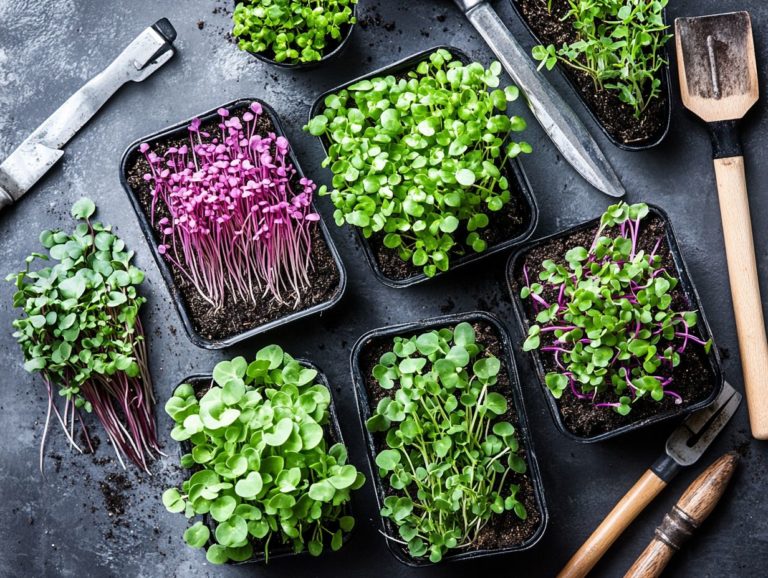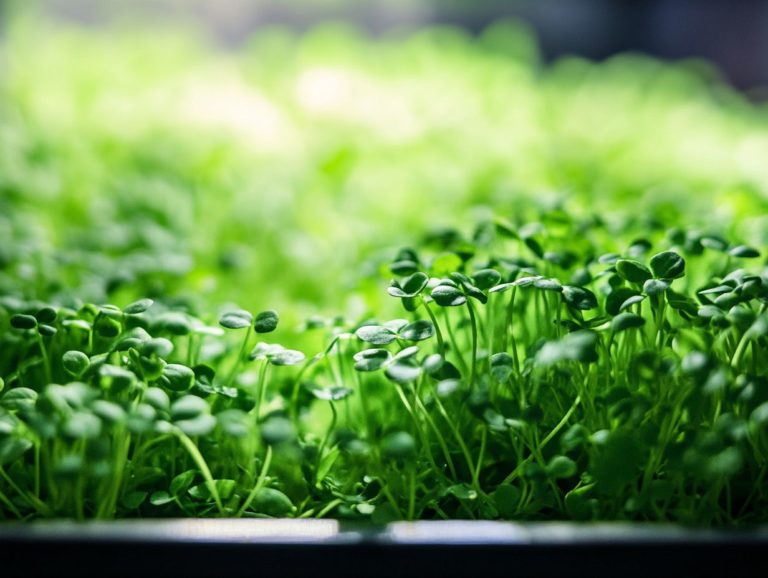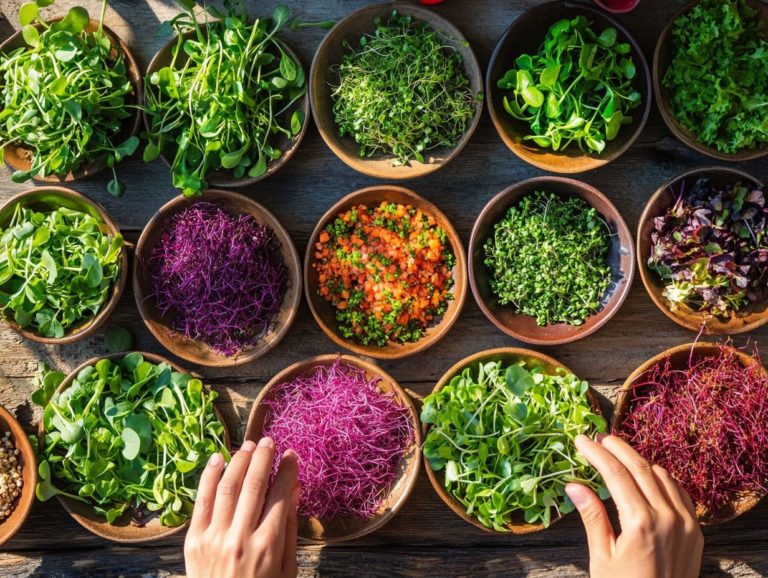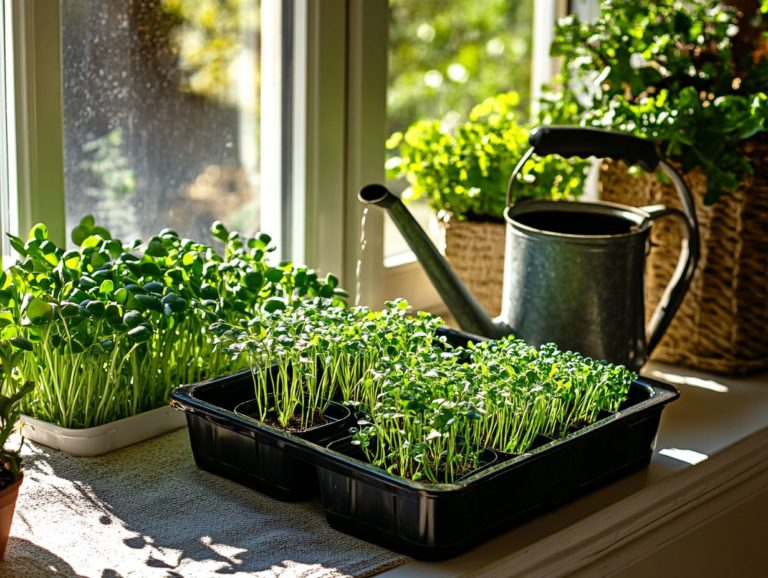What Are the Best Tools for Microgreen Harvesting?
Microgreens have taken the food scene by storm, offering not only vibrant flavors but also great nutrition in small greens. Their versatility in growing methods, including traditional soil and Hydroponic Grow Mats, makes them a popular choice among gardeners.
Yet, growing them is merely the first step. Harvesting these delicate plants calls for the right tools and techniques to maximize yield and minimize waste, such as using a power washer for cleaning and effective methods for removing roots.
Get ready to dive into everything you need to know about microgreens! Whether you’re nurturing a home garden or running a professional operation, you’ll discover tips and insights that will elevate your microgreen experience.
Let’s explore the tools and methods that will make harvesting a breeze, ensuring you maximize your yield while minimizing waste by using quality produce bags and cleaning tools.
Contents
- Key Takeaways:
- Benefits of Growing Microgreens
- Harvesting Microgreens
- Best Tools for Microgreen Harvesting
- Tips for Using Microgreen Harvesting Tools
- Alternative Methods for Harvesting Microgreens
- Frequently Asked Questions
- What Are the Best Tools for Microgreen Harvesting?
- Do I need any special tools for harvesting microgreens?
- What type of scissors should I use for harvesting microgreens?
- How should I clean my harvesting tools?
- Why do I need a spray bottle for harvesting microgreens?
- Are there any other tools that can be helpful for harvesting microgreens?
Key Takeaways:
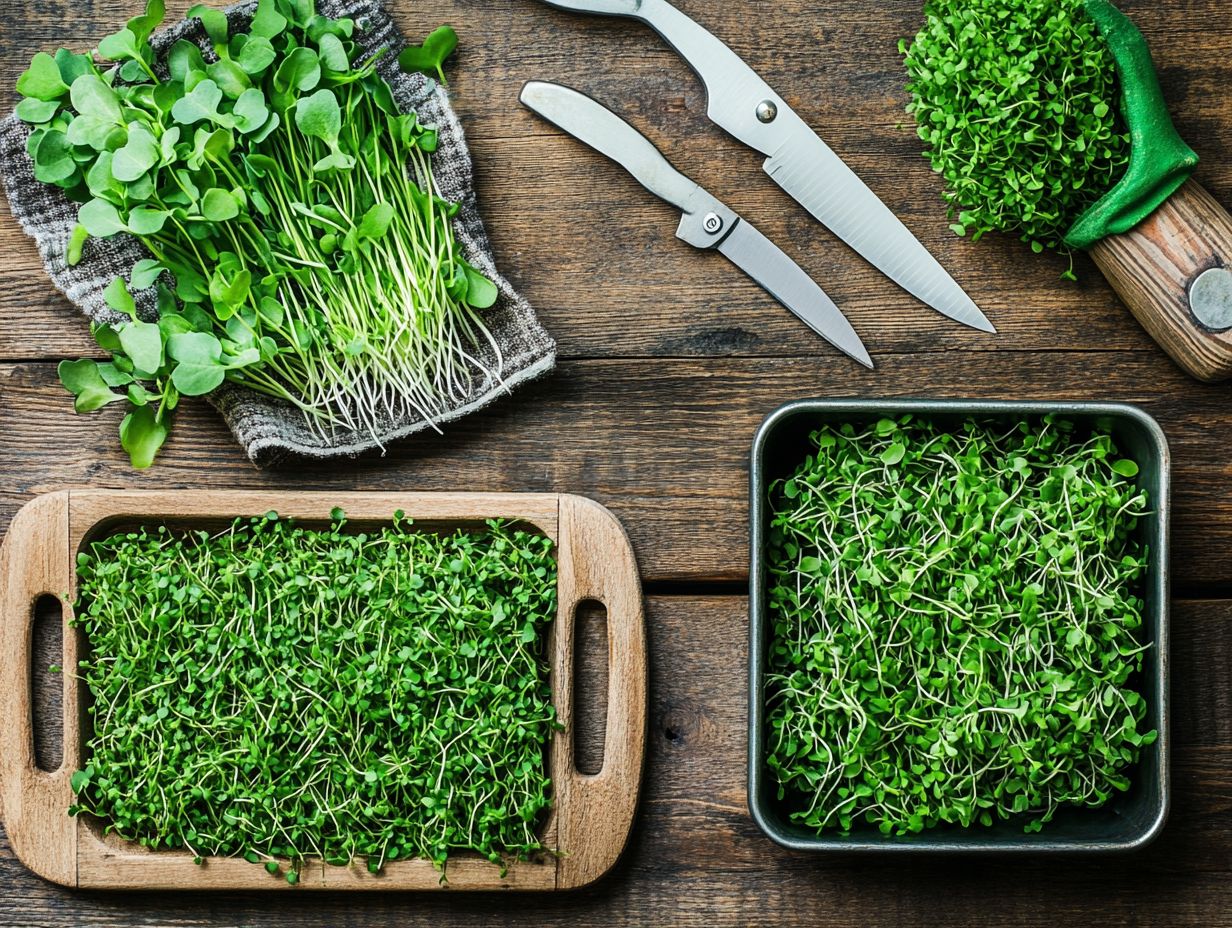
- Invest in quality microgreen harvesting tools to ensure efficient and effective harvesting.
- Hand harvesting is the preferred method for maximizing yield and minimizing waste in microgreen harvesting.
- Consider alternative methods such as machine harvesting for larger scale production of microgreens.
What are Microgreens?
Microgreens are your ticket to a vibrant garden, as they are young, edible plants harvested just after the first true leaves, or cotyledons (the initial leaves that sprout from seeds), have developed usually within a quick 7 to 21 days post-germination. They come from a diverse array of plant families and can sprout from seeds of vegetables, herbs, or even spices, making them an incredibly versatile choice whether you re a home gardener or a commercial grower.
With their intense flavors and striking colors, microgreens are not just visually appealing. You can grow them easily indoors or outdoors, using soil or innovative hydroponic systems like Hydroponic Grow Mats.
The variety of microgreens available is impressive, including options like arugula, radish, and basil, each contributing its unique taste and nutritional benefits to your meals. To create the ideal growing environment, ensure your seedlings have ample light, consistent moisture, and good air circulation these elements are key to helping them thrive.
Culinary possibilities with microgreens are practically endless. They can elevate salads, enhance sandwiches, and even serve as exquisite garnishes for gourmet dishes, making them an invaluable addition to your produce collection. By choosing Hydroponic Grow Mats, you not only simplify the growing process but also boost yield and flavor, paving the way for a more sustainable and delightful way to enjoy fresh produce.
Benefits of Growing Microgreens
Growing microgreens presents a wealth of benefits, including exceptional nutritional value, ease of cultivation, and cost-effectiveness, making them a superb choice for both novice and seasoned gardeners.
These petite powerhouses are brimming with vitamins, minerals, and antioxidants, frequently boasting higher nutrient levels than their fully matured counterparts. They also thrive in limited spaces, enabling urban dwellers to cultivate their own fresh produce, even within the confines of a small apartment.
Nutritional Value and Ease of Growing
Microgreens pack a nutritional punch. They often have more vitamins and minerals than mature plants, making them an invaluable addition to your diet. They re incredibly easy to grow, requiring minimal equipment and space, perfect for both seasoned gardeners and those just starting out with seed starters.
Among the standout microgreens, broccoli and kale shine for their remarkable concentrations of vitamins C, E, and K, along with antioxidants that bolster overall health and immune function. Cultivating these nutrient-dense greens is a breeze; simply place seeds in a shallow tray filled with potting soil, ensuring they remain moist but not waterlogged.
With a touch of sunlight and consistent watering, you can harvest fresh, vibrant greens in just a few weeks. Incorporating them into your daily meals whether sprinkled on salads or blended into smoothies can effortlessly boost your nutritional intake.
Harvesting Microgreens
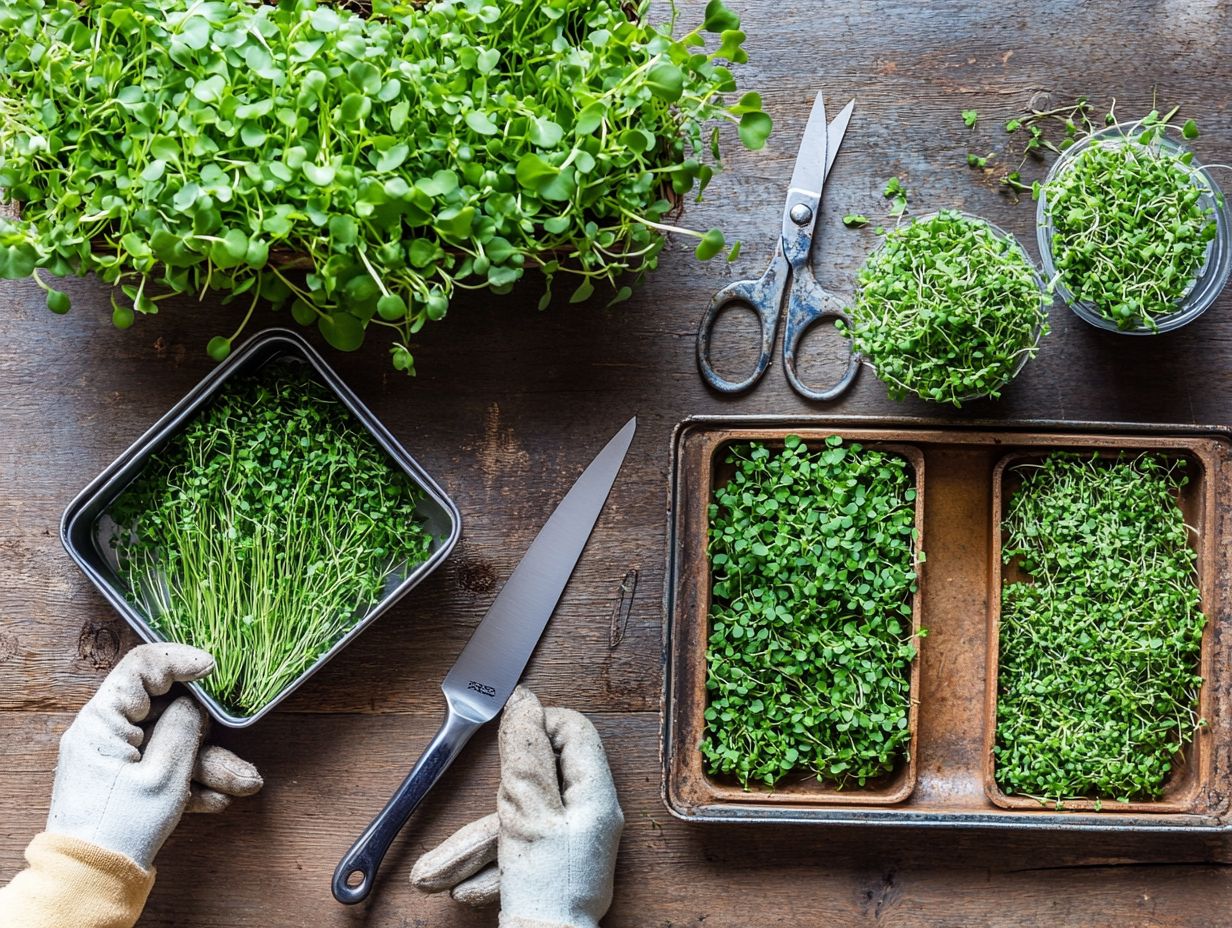
Harvesting microgreens requires attention to timing and technique to achieve the finest flavor and nutritional value. It’s also crucial to maintain a pristine environment to prevent contamination.
Timing is vital; aim to harvest your microgreens right when they reach their peak size usually just before they start to flower. Using the right tools, like stainless steel scissors or a stainless steel dough pastry cutter, is equally important. These tools ensure hygiene and enhance the quality of your harvest.
Tools and Techniques for Harvesting
The right tools and techniques can dramatically improve the quality of your produce and enhance your efficiency. Incorporating tools like a power washer for thorough cleaning or a mini rake for gathering cut microgreens can streamline your workflow. This way, you maximize yield while minimizing waste.
Using a well-calibrated sprayer allows for precise water application, crucial for maintaining perfect moisture levels during the growth phase. Efficient cleaning devices not only save time but also promote the health of future crops by significantly reducing contamination risk.
Knowing when to cut your microgreens guarantees maximum flavor and nutrient retention. By integrating these tools and techniques into your harvesting routine, you can achieve a higher-quality product and boost your overall efficiency.
Best Tools for Microgreen Harvesting
The best tools for harvesting microgreens will boost your efficiency and keep your greens pristine and uncontaminated. Essential instruments include:
- Mini washers designed specifically for cleansing freshly harvested microgreens.
- Reusable mesh bags that facilitate both storage and transport.
- A humidity meter, a device that measures moisture levels in the air, to monitor conditions for flourishing greens.
Investing in these tools streamlines your workflow and enhances the quality of your harvest.
Top Picks for Efficient and Effective Harvesting
For efficiently and effectively harvesting microgreens, selecting the right tools is essential. Consider a humidity meter to monitor environmental conditions, and a manual sprayer for easy watering and sanitation.
A sharp pair of scissors or a dedicated microgreens harvester significantly streamlines your cutting process. This ensures a clean and precise cut, minimizing damage to delicate plants. Using trays with drainage holes is crucial; they allow excess water to escape, preventing root rot and promoting healthier growth.
If you’re growing indoors, a grow light is an invaluable tool that enhances the photosynthesis process, leading to vibrant, nutrient-rich greens. By integrating these tools into your harvesting routine, you can boost efficiency and elevate the overall quality of your microgreens.
Tips for Using Microgreen Harvesting Tools
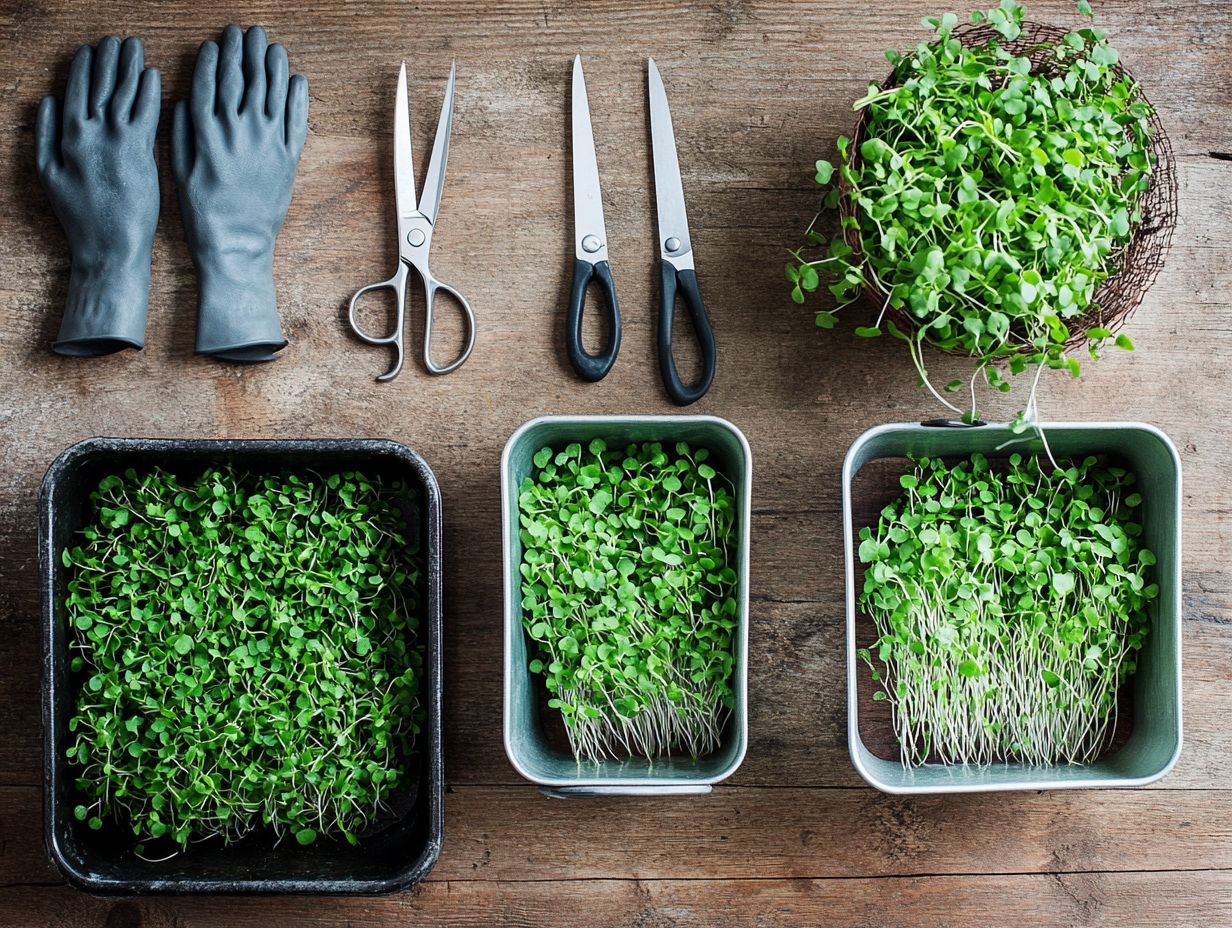
To maximize your yield and minimize waste when harvesting microgreens, it’s essential to use the right techniques with your tools. By utilizing your tools correctly, you can efficiently cut bulk microgreens while preserving the hygiene and quality of your produce.
Always remember to sanitize your tools before and after use to prevent contamination. Pay attention to your cutting angle; cutting at the right angle is crucial to avoid damaging the plants.
Maximizing Yield and Minimizing Waste
Maximizing yield while minimizing waste during the harvesting process is essential for anyone cultivating microgreens. Techniques like cutting at the right height and ensuring your tools are sharp can significantly boost your harvesting efficiency, resulting in cleaner cuts and reduced waste.
Timing your harvest to coincide with the peak growth of your microgreens is crucial for optimizing your yield. A systematic approach by organizing your harvest in small batches can lessen the risk of spoilage, ensuring that more of your greens make it to their intended market.
Incorporating methods like vertical farming, which means growing plants in stacked layers to save space, and hydroponics, or growing plants in water without soil, not only saves space but also accelerates growth rates. By implementing these practices, you enhance your own success while contributing to an eco-friendly ethos and a healthier ecosystem.
Alternative Methods for Harvesting Microgreens
Exploring alternative methods for harvesting microgreens can present distinct advantages in terms of efficiency and the ability to grow.
When comparing hand harvesting to machine harvesting, each approach has its merits. Hand harvesting offers a delicate touch, enabling you to make careful cuts that preserve the quality of your microgreens. Machine harvesting, however, can significantly reduce time and labor demands, making it appealing for larger-scale operations.
Comparing Hand Harvesting vs. Machine Harvesting
Each method presents its own advantages and challenges that can significantly shape your overall process. Hand harvesting allows for that extra touch of precision and care, minimizing damage to those delicate seedlings.
Conversely, machine harvesting, equipped with the right tools, can substantially boost efficiency and speed, especially when dealing with larger quantities. Your choice between these two methods can profoundly impact not only the quality of the microgreens but also the labor dynamics within your operation.
Hand harvesting promotes a meticulous selection process, enabling you to pick only the healthiest plants, which enhances the freshness and flavor of your product. However, machine harvesting excels in scaling up production, particularly in commercial environments where every second counts. If machines aren’t calibrated correctly, they may jeopardize quality by unintentionally bruising or slicing the greens.
Therefore, your decision hinges on finding the right balance between quality and productivity, ensuring that the final product meets your high standards.
Frequently Asked Questions
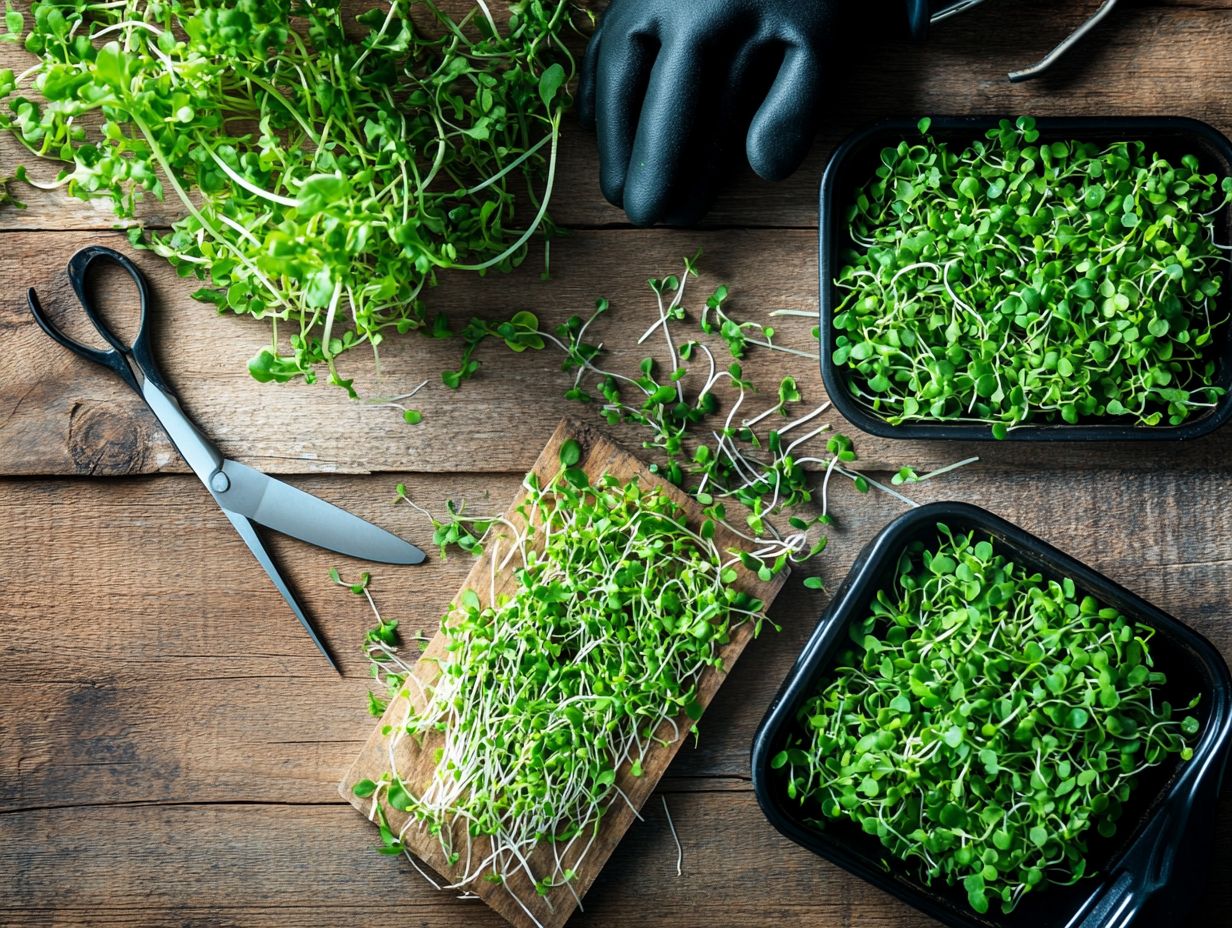
What Are the Best Tools for Microgreen Harvesting?
The best tools for microgreen harvesting include sharp scissors, a clean cutting board, and a spray bottle for misting the greens.
Do I need any special tools for harvesting microgreens?
While specialized tools for microgreen harvesting do exist, they are not necessary. Simple household tools such as scissors and a cutting board will suffice.
What type of scissors should I use for harvesting microgreens?
Sharp, clean scissors are the best choice for harvesting microgreens. Avoid using serrated scissors as they can crush the delicate greens.
How should I clean my harvesting tools?
Keeping your tools clean is essential for a successful harvest! Simply wash them with soap and hot water after each use.
Why do I need a spray bottle for harvesting microgreens?
Misting the greens with water before harvesting can help loosen any dirt or debris stuck to the leaves. This makes it easier to harvest and clean the microgreens.
Are there any other tools that can be helpful for harvesting microgreens?
While not necessary, some microgreen growers find that using a small fan or a gently blowing hairdryer can help remove excess moisture from the greens before harvesting.

